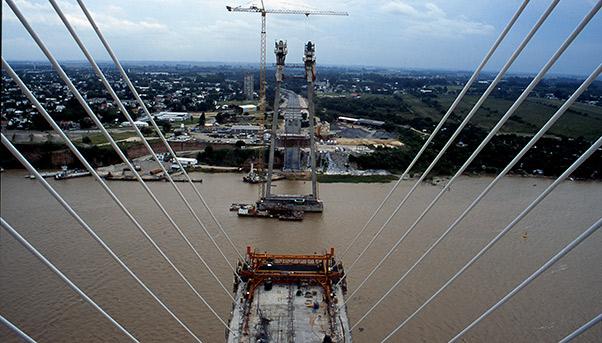It was a long time coming but the farmers of Argentina’s grain belt finally got their bridge.
With the cutting of the ribbon at the inaugural ceremony, the Rosario-Victoria, stretching majestically across the Paranà River, opened for traffic in 2003.
Although it took only five years to build, the bridge had been decades in the waiting. The cities of Rosario and Victoria in Argentina’s northeast had long dreamed of such a structure to overcome what they considered an obstacle to their development. Located on either side of the Paranà, they were a mere 60 kilometres apart. But cars and trucks had to travel 120 kilometres north to use a subfluvial tunnel to cross the river – costing them extra time and money. The bridge, of course, changed everything.
«The residents of Santa Fe and Entre Ríos had more often than not dreamed of the possibility of crossing the Paraná in little time. Well, this morning they (did),» wrote La Nacion newspaper in an article published at the time of the inauguration. With the payment of a toll to access the bridge of two dual carriageways, drivers could reach either city in less than an hour’s time. Santa Fe and Entre Ríos are the provinces where the cities are located. Built for more than $300 million, the bridge is the outcome of Argentina’s efforts to foster greater trade with neighboring Brazil, Chile and Uruguay – all of which are members of the Mercosur trade bloc.

As the world’s third biggest soybean exporter, Argentina had everything to gain from the construction of a bridge in Rosario because the city is its main grains hub with an array of ports and crushing plants. The bridge would help Rosario become a major transportation and distribution centre by facilitating the creation of a road corridor between Chile on the Pacific Coast and the three other countries on the Atlantic.
It would also increase tourism to Victoria and beyond by improving connections between the northeastern provinces of Entre Rìos – of which the city is the capital – Corrientes and Misiones and the rest of the country.
Built by an international consortium led by Impregilo, one of the predecessors of Salini Impregilo, the Rosario-Victoria Bridge stretches over a valley with islands and marshes through which runs the river. It is composed of a main bridge, a viaduct on either side, and 12 minor bridges.
The main bridge is a cable-stayed structure 608 metres long with a central span of 350 metres and two lateral spans of 129 metres each. The east viaduct provides access to the bridge on the Victoria side, running for 2.4 kilometres. The west viaduct on the Rosario side is half as long at 1.1 kilometres. The 12 minor bridges are built on a string of islands, running for a total of 8.2 kilometres.
The total length of the project is 60 kilometres. Every year, it is the stage for a marathon, which has thousands of runners cross the bridge two times.

